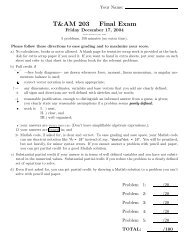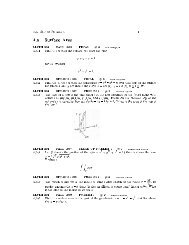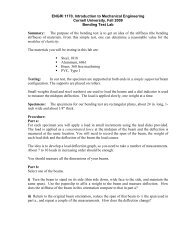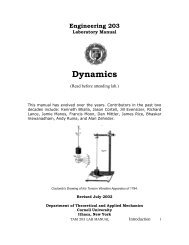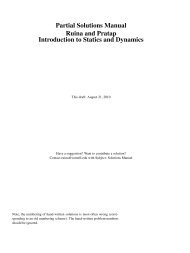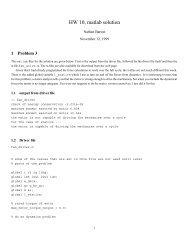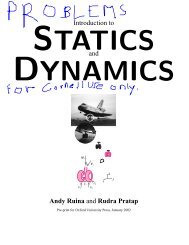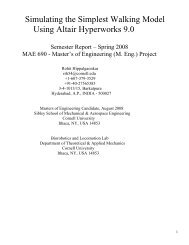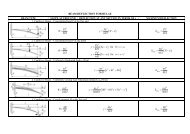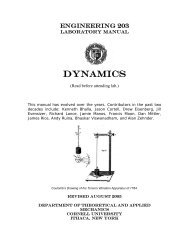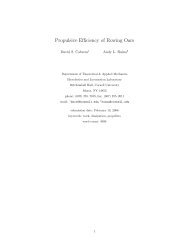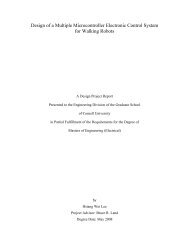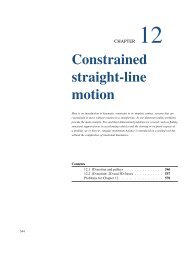Introduction to and Andy Ruina and Rudra Pratap
Introduction to and Andy Ruina and Rudra Pratap
Introduction to and Andy Ruina and Rudra Pratap
You also want an ePaper? Increase the reach of your titles
YUMPU automatically turns print PDFs into web optimized ePapers that Google loves.
8 Chapter 0. Detailed Contents Detailed Contents<br />
Box 14.3 The work of a moving force <strong>and</strong> of a couple . . . 760<br />
Box 14.4 The vec<strong>to</strong>r triple product * A ¢ . * B ¢ * C / . . . . . 761<br />
14.3 Kinematics of rolling <strong>and</strong> sliding . . . . . . . . . . . . . . . 767<br />
Box 14.5 The Sturmey-Archer hub . . . . . . . . . . . . . 770<br />
14.4 Mechanics of contact . . . . . . . . . . . . . . . . . . . . . 780<br />
14.5 Collisions . . . . . . . . . . . . . . . . . . . . . . . . . . . 798<br />
15 Kinematics using time-varying basis vec<strong>to</strong>rs 820<br />
Here is a second take on the kinematics of particle motion but now using<br />
base vec<strong>to</strong>rs which change with time. The discussion of polar coordinates<br />
started in Chapter 13 is completed here. Path coordinates, where one<br />
base vec<strong>to</strong>r is parellel <strong>to</strong> the velocity <strong>and</strong> the others orthogonal <strong>to</strong> that,<br />
are introduced. The challenging <strong>to</strong>pic of kinematics of relative motion<br />
is in two stages: first using rotating base vec<strong>to</strong>rs connected <strong>to</strong> a moving<br />
rigid object <strong>and</strong> then using the more abstract notation associated with<br />
frame-dependent differentiation <strong>and</strong> the famous “five term acceleration<br />
formula.”<br />
15.1 Polar coordinates <strong>and</strong> path coordinates . . . . . . . . . . . . 821<br />
15.2 Rotating frames <strong>and</strong> their base vec<strong>to</strong>rs . . . . . . . . . . . . 836<br />
Box 15.1 The P * Q formula . . . . . . . . . . . . . . . . . . 845<br />
15.3 General formulas for * v <strong>and</strong> * a . . . . . . . . . . . . . . . . . 850<br />
Box 15.2 Moving frames <strong>and</strong> polar coordinates . . . . . . 856<br />
15.4 Kinematics of 2-D mechanisms . . . . . . . . . . . . . . . . 862<br />
15.5 Advanced kinematics of planar motion . . . . . . . . . . . . 875<br />
Box 15.3 Skates, wheels <strong>and</strong> non-holonomic constraints . . 877<br />
16 Constrained particles <strong>and</strong> rigid objects 888<br />
The dynamics of particles <strong>and</strong> rigid bodies is studied using the relativemotion<br />
kinematics ideas from chapter 15. This is the caps<strong>to</strong>ne chapter<br />
for a two-dimensional dynamics course. After this chapter a good student<br />
should be able <strong>to</strong> navigate through <strong>and</strong> use most of the skills in the<br />
concept map inside the back cover.<br />
16.1 Mechanics of a constrained particle . . . . . . . . . . . . . . 890<br />
Box 16.1 Some brachis<strong>to</strong>chrone curiosities . . . . . . . . . 896<br />
16.2 One-degree-of-freedom 2-D mechanisms . . . . . . . . . . . 912<br />
Box 16.2 Ideal constraints <strong>and</strong> workless constraints . . . . 913<br />
Box 16.3 1 DOF systems oscillate at E P minima . . . . . . 918<br />
16.3 Multi-degree-of-freedom 2-D mechanisms . . . . . . . . . . 926<br />
Appendices 956<br />
A Units & Center of mass theorems 956<br />
Some things that are important, but don’t fit in the flow of a homeworkdriven<br />
course.<br />
First, issues related <strong>to</strong> units <strong>and</strong> dimensions, most importantly that a<br />
quantity is the product of a number <strong>and</strong> a unit. Thus units are part of a<br />
calculation. Some simple advice follows: a) balance units, b) carry units<br />
<strong>and</strong> c) check units. Rules for changing units also follow.



